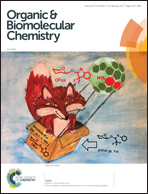The first example of palladium-catalyzed cascade amidine arylation–intramolecular ester amidation for the synthesis of hypoxanthines: application to the synthesis of 8-azanebularine analogues†
Abstract
8-Azanebularine analogues display interesting antiviral, antitumour and biochemical activities. However, typical glycosylation of 8-azapurines always resulted in the desired products in low yields due to the lack of stereo- and regioselectivity of the glycosylation reaction. Herein, a concise synthetic route toward 8-azanebularine analogues has been developed. Key steps involve a copper-catalyzed 1,3-dipolar cycloaddition of a 1-β-azido sugar moiety with ethyl 3-bromopropiolate and a palladium-catalyzed cascade amidine arylation–intramolecular ester amidation reaction to build the hypoxanthine structural motif. This protocol affords a facile methodology for the synthesis of a series of novel 8-azanebularine analogues from the readily accessible 1-β-azido sugar moiety under mild conditions.


 Please wait while we load your content...
Please wait while we load your content...